CADDXFPV’s first FPV drone, the GoFilm 20, adopts a CineWhoop-style design with a 360-degree blade protector and onboard Walksnail Moonlight FPV system. It is intended for both beginners and experienced FPV pilots alike. With a wheelbase of just 94mm, it is suitable for indoors and flying outside through tight spaces.
I remember my first flight using FPV Goggles and how immersive it was. Despite being disoriented and having motion sickness, I wanted more, so I changed the battery and fired up the drone again and again. It is probably the closest feeling humans can experience to flying like a bird. I used low-resolution analog FPV at that time, and now digital systems like the Walksnail Avatar HD provide better video quality and a much more realistic user experience.
The biggest advantage of the CADDXFPV GoFilm 20 over its direct competitor, the AVATA 2, is that it weighs less than 250 grams, including the battery. Under this weight limit, you can fly your drone in most regions, including the US, without any pilot license.
CADDXFPV GoFilm 20 with Walksnail Moonlight 4K
Disclosure: I received this 2″ CineWoop in a product review collaboration with CaddxFPV. Product specs and quality may vary according to the manufacturer’s reliability, so I cannot guarantee that you will get a unit that performs the same as seen in my review.
Caddx is an old player in the FPV industry; they were first known for their high-quality analog FPV cameras and later for the HD digital Vista kit designed in close collaboration with DJI. Their next bang was developing the Walksnaul ecosystem, an alternative solution to the existing digital FPV solutions.
Three weeks ago, Caddx FPV showed a teaser photo of their first drone with the “Explore the Boundary” slogan. The next day, they emailed me asking if I was interested in reviewing their upcoming drone, but without revealing any more details about it. Due to some complications with FedEx and the Labor Day and Orthodox Easter holidays, receiving the package took close to 15 days, so I missed publishing the first review of the GoFilm20.
The drone comes in the box with a set of spare propellers with screws, a spare battery strap, an ND8 filter, a USB data cable, a VTX FW upgrade cable, a hex wrench, and a quick start guide (CN/EN).
CADDXFPV GoFilm 20: Design and main components
At 115g (4.06oz) and 133×123×39mm (5.2×4.8×1,5″), it practically fits into your palm, making it one of the smallest and lightest 2-inch 4K FPV drones. The GoFilm 20 adopts a Pusher-Whoop design with inverted motors. The frame has two parts: a top carbon fiber plate that holds the motors and the 360-degree Whoop blade protector. The 2.5mm thick CF plate has a nice black paint finish. The PAVO25 that I recently built had a similar frame structure. The only thing that makes the design somehow unique is the plastic cover Caddx FPV logo that protects the camera.
The tiny 1303 6000KV motors are paired with tri-blade HQprop T2×2×3 propellers. Considering that it is intended to be used with 4S LIPOs, the 6000KV is pretty high, making the little drone speedy and agile.
In the center of the frame is an F405HD AIO flight controller with an integrated 20A ESC and UART ELRS radio receiver. Under the FC is the Walksnail Moonlight digital video transmitter. The AIO FC is installed on the top frame, and the VTX on the plastic blade guard allows easy access to all the parts. You need to remove just five screws to take it apart in case you have to do a repair.
The VTX and RX antennas are thoughtfully secured on a 3D-printed TPU mount at the drone’s tails. The original Moonlight antennas have been replaced with smaller dipole antennas to be as light as possible. The onboard RX has v3.0 ExpressLRS firmware and a full-size T-type antenna that attaches to FC through a UFL connector.
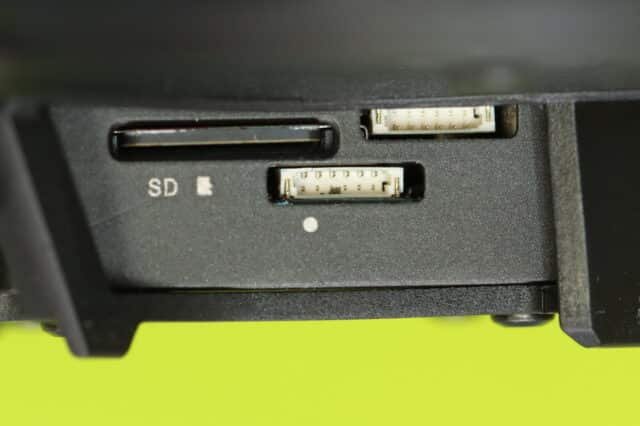
Both FC’s micro USB port and VTX’s memory card slot are easily accessible. If you are looking to upgrade your CADDXFPV GoFilm 20 with a GPS module or other sensor, there is a free UAURT port for this purpose (find below the FC’s pinout)
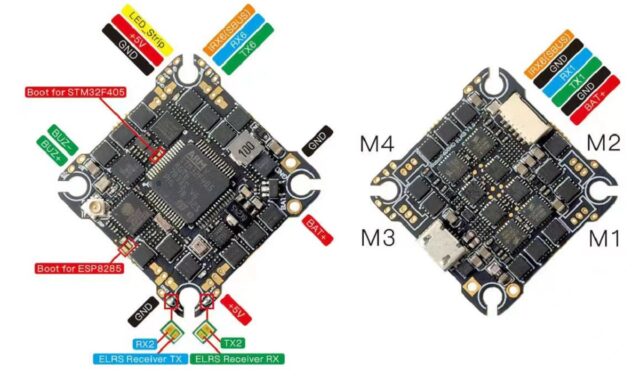
The battery is installed above the drone; it is possible that an installation at the bottom would have helped stability. If you plan to use higher-capacity batteries, you must replace the stock velcro with the spare one included in the box (it is about 3cm longer).
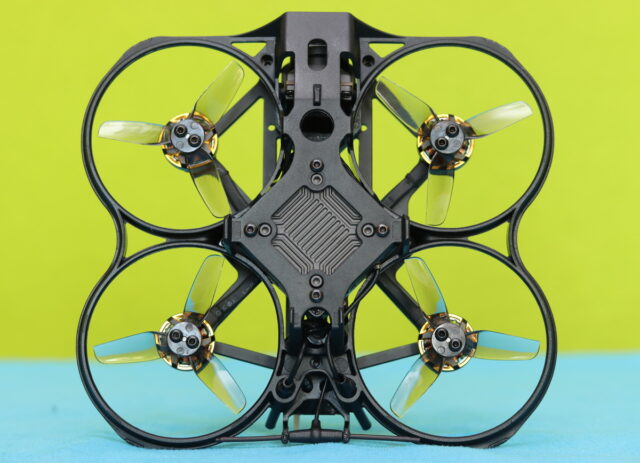
CADDXFPV GoFilm 20: FPV system | Video quality
As mentioned, the GoFilm20 is built around the newest and most advanced Walksnail FPV system, the Moonlight. From the product name, you can guess that it promises a superior low-light performance. Of course, it is also an excellent choice for flying in strong daylight as it comes in the kit with a neutral density filter (you can choose from ND16 and ND32) to quickly adapt to different light conditions.
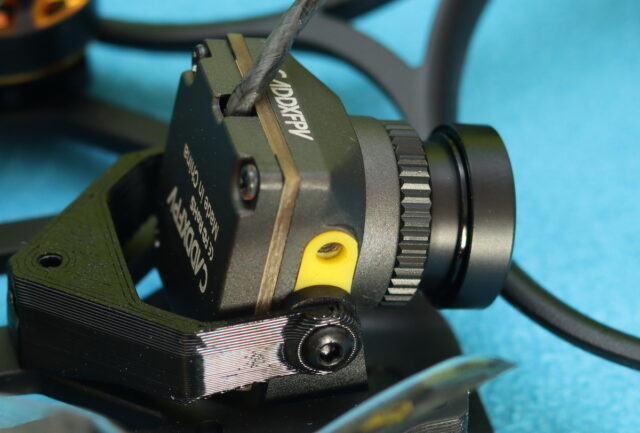
The Walksnail Moonlight system can transmit 1080p video feed over long distances to your FPV goggles and onboard record up to 4k@60fps videos. Stable, jello-free videos can be shot thanks to the built-in EIS and Gyroflow support. Unfortunately, you can’t have all the features at the same time. When the high frame rate is selected, VTX recording resolution is limited to 720 and 1080p (no 2.7k or 4K available). Also, built-in image stabilization can be activated only at 2.7K. When EIS is enabled, no gyro data is recorded for post-stabilization in the Gyroflow app. The lens profile for the Moonlight camera is available on GitHub.
Besides resolution and frame rate, the Moonlight camera supports manual settings for:
- ISO
- Sharpness
- Exposure Value
- Saturation
- White Balance
- Shutter Speed
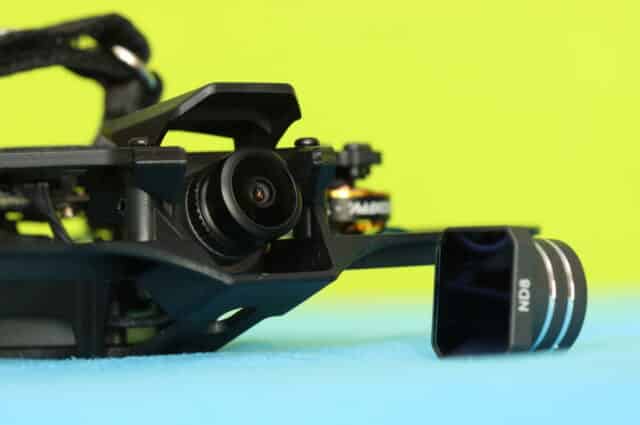
My Walksnail Moonlight test looks almost as good as the one recorded with the DJI O3 system, but to be truthful, I’m afraid that they can’t compete with a GoPro’s quality.
Caddx GoFilm20: Needed to be completed
Unlike the DJI Avata 2 combo, a ready-to-fly kit (RTF), the GoFim 20 drone is offered in a “PNP package,” meaning that you will need a couple of extra accessories to use it.
As mentioned, it has an XT30 battery plug and supports 3-4S batteries. To maintain a good balance between flight time and performance, I recommend using batteries with 550mAh and 850mAh. Each battery provides about 5 minutes of flight time so that you will need 3-5 of them. A PD smart charger with an XT30 port and a parallel board is also required.
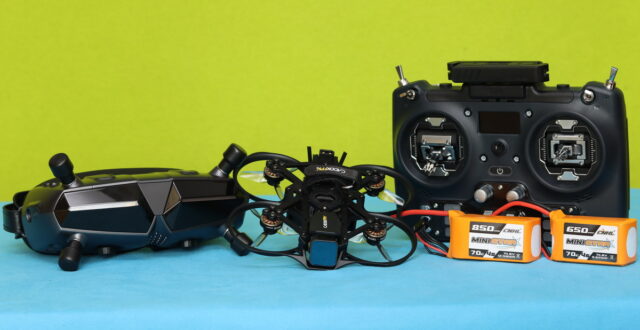
The GoFim 20’s AIO flight controller features an onboard ExpressLRS radio receiver that can be paired with any ELRS radio controller; for the best range, I recommend the Jumper T14 with a built-in 1W TX module.
For FPV flights, besides the battery and transmitter, you will need a compatible FPV monitor. For the best user experience, I suggest the Walksnail Avatar HD Goggles X, but you can also choose the AVATAR VRX if you are on a tight budget and already own an FPV headset with HDMI input.
Pricing and availability
Many could say the GoFilm 20 is overpriced because it is not a versatile DJI drone. But, considering that just the onboard Walksnail Moonlight kit costs close to 200 bucks, the $399 is pretty fair. You can pre-order it starting the 29th of April directly from CaddxFPV’s official online store. Remember that the package includes only the bare drone and will need batteries.
If needed, a set of CADDXFPV 1303 6000KV motors costs $68, and a CADDXF4_AIO_ELRS flight controller costs $59.99. A complete GoFilm20 frame kit or individual repair parts can be purchased here.
Should you buy the GoFilm 20 CineWhoop?
If you have experience with custom-made FPV drones and already own an ELRS radio transmitter and Walksnail Avattar Goggles, you will probably love the Gofilm 20.
Sub250g drones are great because they’re regulation-friendly in most regions, and you can stay under this weight limit with the GoFilm20, including when using an up to 1100mAh battery. The small size allows flying in tight spaces, while the 6000KV motors provide power to fly outdoors even in windy conditions.
If this CineWhoop isn’t for you
FPV isn’t for everyone, and FPV quadcopters aren’t suitable for all filming scenarios or still photography. If you mostly like to shoot aerial videos and take selfies from the air, I suggest looking for a GPS-enabled camera drone with gimbal stabilization. One of the best options under 250g is the Mini 4 Pro.
The GoFilm 20 is not ready to fly out of the box; you must configure it and pair it with your existing accessories. So, if your aim is simply to get up in the air without customizing the BetaFlight configurator or flashing new ELRS firmware and have all the required accessories included in the kit, the Avata2 is probably more for you.
CADDXFPV GoFilm 20: Pre-flight Configuration and Performance
The GoFilm 20 drone comes fully assembled, and you need to do only a few configuration steps before enjoying your first flight.
First, you must bind it to your radio controller -the RX and TX must run the same major ELRS software (2.XX or 3.XX). Pairing mode can be activated by powering ON/OFF the drone three times.
Next, connect the FC to your computer through the micro USB port and run the BetaFlight configurator (BFC). Note: The propellers are installed, so you should carefully configure any settings, especially the ESC and motor configuration. Note: During the configuration, the VTX heats up quickly; in no time, it achieved 100°C (212°F), so it is recommended to use an external fan for cooling.
In the BFC, I adjusted the switch and button layout, assigned flight modes, and customized OSD settings. I didn’t touch any PID settings before a couple of test flights. It is recommended that the ESC beacon be activated, which could help find the drone if you crash it in high grass. BTW, “Turtle mode – Flip-back” mode can also be activated in BFC.
Maybe the CaddxFPV GoFilm 20 does not have the flight performance of a 5″ racer, but it is fun to fly and pretty agile. If you have the skill, you can fly through tight spaces such as your car, allowing unique footage. With a 4S 650mAh battery, you can expect about 5 minutes of flight time. Increasing battery capacity adds more weight, making it less responsive. Being so noisy, I nicknamed it “Angry Bird” :)
Technical parameters
| Drone | Frame | Whoop style, 94mm wheelbase |
| FC | Super F405HD ELRS AIO | |
| FPV system | Walksnail Moonlight Kit | |
| Propulsion system | Motors: 1303 6000KV Props: HQprop T2×2×3 |
|
| Receiver | Onboard ELRS 2.4G UART | |
| Battery | 4S 450-650mAh | |
| Dimensions | 133×123×39mm | |
| Weight | 115±5g | |
| Flight controller | MCU | STM32F405RGT6 |
| GYRO and IMU | ICM42688 | |
| Barometer | BMP280 | |
| ESC | 20A 4in1 (Bluejay firmware) | |
| Blackbox | 8MB | |
| Battery compatibility | 2~4S Lipo/Lihv | |
| Firmware | Betaflight 4.4.3 target CADDXF4_AIO_ELRS | |
| Dimensions | 25.5×25.5mm | |
| FPV | Communication Frequency | 5.725-5.850 GHz |
| Transmitter Power (EIRP) | FCC: <30dBm; CE: <14dBm; SRRC: <20dBm; MIC: <25dBm | |
| Camera | Sensor: Starlight FOV: Max 160° Aperture: F2.1 ISO: 100-25600 |
|
| Recording | Resolution 4K@30/60fps, 2.7K@30/60fps, 1080p@100/60fps; 720p@60fps Max Mbps: 150Mbps Video format: MP4 (H.264) |
|
| Image stabilization | EIS and Gyroflow support | |
| Average delay | 22ms |
You Can Trust Our Reviews!
Since 2014, FirstQuadcopter has reviewed, thoroughly tested, and rated hundreds of products, including drones, gimbals, power stations, action cameras, 3D printers, and other high-tech gear to help you make better buying decisions.

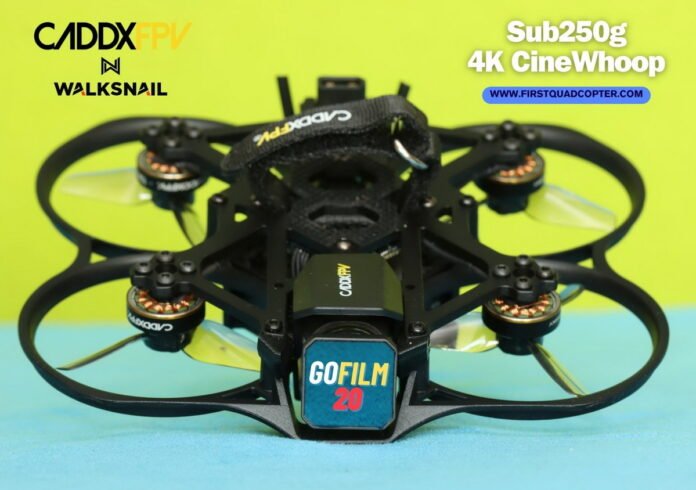
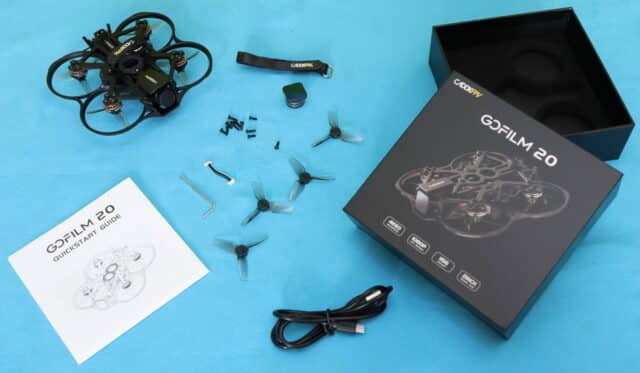
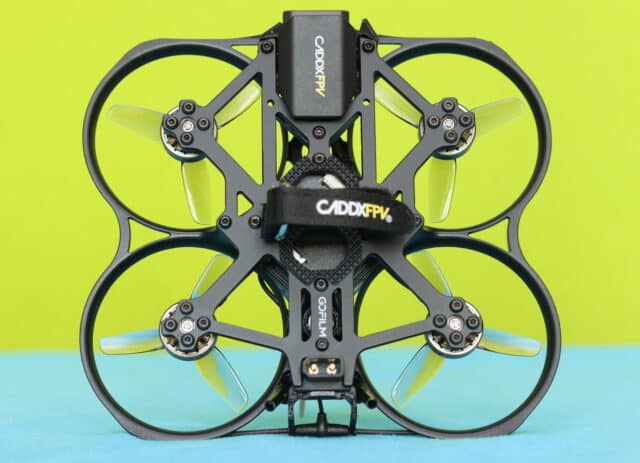
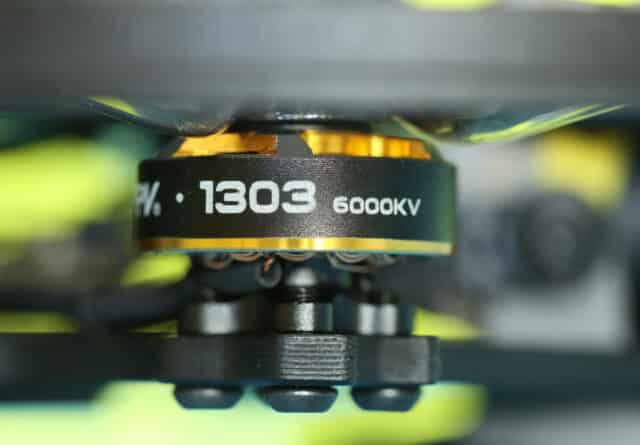
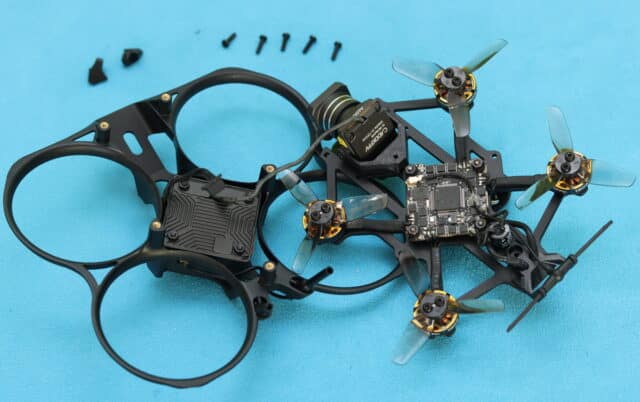
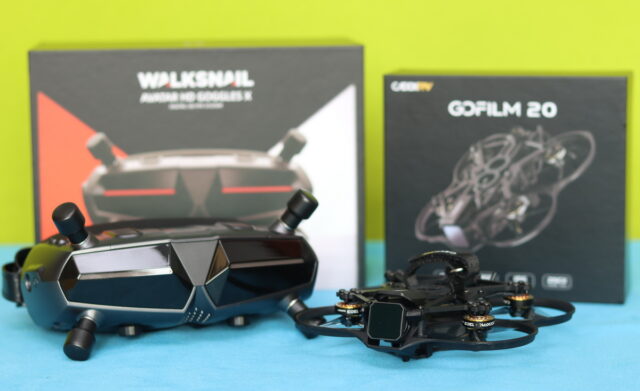
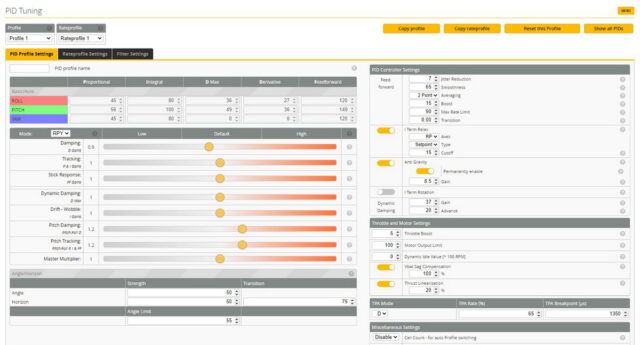
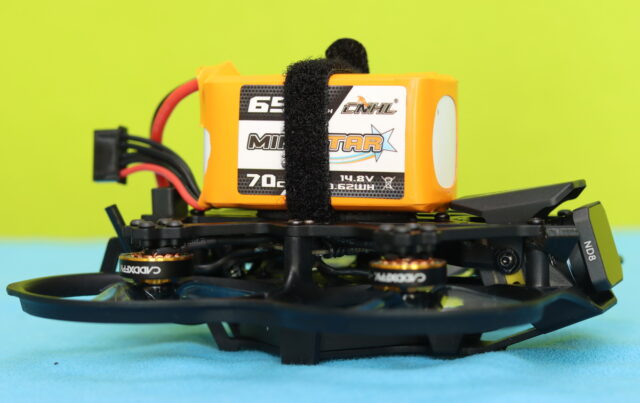
It would be nice if CaddxFPV could release a bigger GoFilm 30 that can carry a GoPro camera.
dump question, can I replace the Walksnail kit with a DJI one?
Is there any way to improve the range of the GoFime20? I can’t fly it beyond 500 meters.
Any GPS version of the GoFilm 20?
perfecto for indoor fun during the winter
Just got the GoFim 20.
What micro sd cards would you recommend
Cheers
Can be the GoFilm20 installed with a GoPro 13?
No! The 2″ drones are too small for full size action cameras (GoPro).
I love this GoFilm20! In optimal conditions, you might expect a range of up to 1 kilometer, although in urban environments with lots of interference, it will be more limited.
To improve the range, I want to replace the stock dipole antennas with full-size Walksnail Avatar HD VTX Antennas.
I see a minor vibration in the test footage. Did you tried to fix it? Maybe a set of new props, PID tuning, or ESC frequency change would help.
totally agree with you. caddx should fix the jello problem!
Enjoy that little walksnail beast!
I am a long time reader of your reviews. I like that in addition to the positive and negative things, you also offer recommendations for using the revised drone. Thanks for the effort!